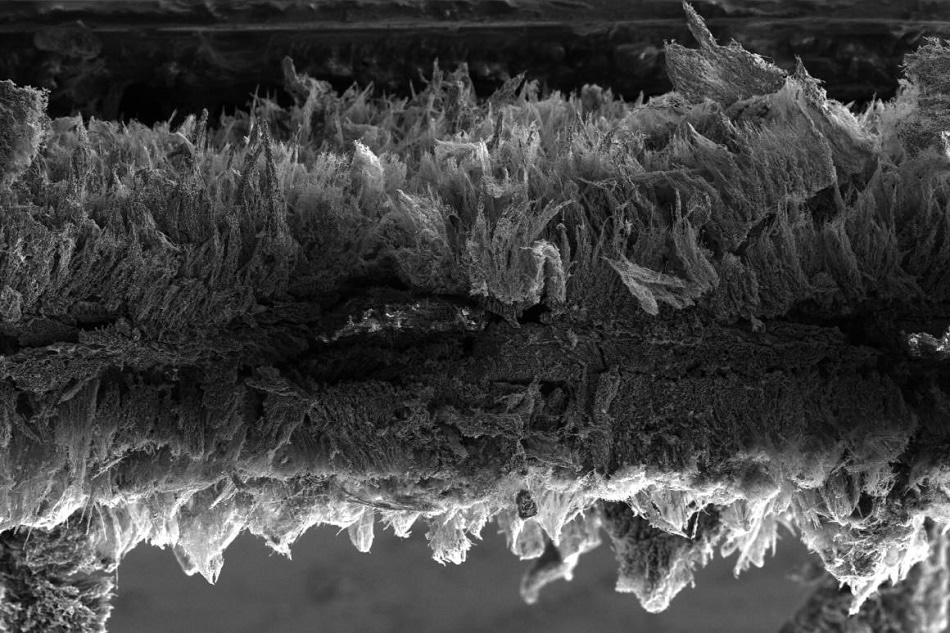 An electron microscope image of an air filter made of graphene fibers, which kills trapped bacteria with short jolts of electricity. Image Credit: Tour Group, Rice University
An electron microscope image of an air filter made of graphene fibers, which kills trapped bacteria with short jolts of electricity. Image Credit: Tour Group, Rice University
There are as many as 1800 kinds of bacteria in the air we breathe, and while many of them are harmless relatives to more deadly pathogens and microbes, in certain environments airborne bacteria pose a threat to human health. The number of bacteria present in the air around us can fluctuate dependent on environmental conditions such as temperature and humidity. Airborne microbes are a major cause of respiratory ailments.
The risk of person-to-person transmission increases in well-populated, enclosed spaces such as the workplace, daily commute, and transport terminals as well as public buildings such as schools and hospitals.
However, a team of researchers at Rice University may have found a solution to quell the spread of harmful airborne microbes by developing a new kind OF filtration device that incorporates graphene.
The system developed by the Rice University team modifies the use of laser-induced graphene (LIG) to snatch airborne pathogens out of the air and then terminate them with a small burst of electricity. According to the paper, published in ACS Nano, the LIG filters can catch bacteria, fungi spores, protein prions, endotoxins and various other contaminants carried by aerosols, droplets, and other particulate pollutants. What’s more is that the LIG filtration system is self-sterilizing which makes it well-suited for hospitals, or other clinical and surgical environments.
So many patients become infected by bacteria and their metabolic products, which for example can result in sepsis while in the hospital. We need more methods to combat the airborne transfer of not just bacteria but also their downstream products, which can cause severe reactions among patients.
James Tour, Professor of Chemistry, Rice University
Tour and his team developed the LIG back in 2014 by shooting a laser at atomically thin polymer sheets which in turn produces a conductive foam of graphene. Until now the LIG foam has been utilized in various applications such as water filtration, electronics and even as part of a collaborative art project.
For their latest development and use in an air filtration system, the Rice team applied the laser to either side of a polyimide sheet and were then able to distribute the graphene fibers unevenly. The outer layer of the LIG resembles a fluffy carpet while the other made up of smaller interlaced structures with a reinforced polymer framework in the middle creating a large surface area.
Furthermore, as graphene is renowned for being an excellent electrical conductor the LIG foam can be heated to 350º Celsius (662º Fahrenheit) by firing a small electrical current through the filter. This method is also efficient as the team declared that only small pulses of electricity are required to heat the trap which eliminates any pathogens and microbes caught inside.
Tour and his lab carried out testing of the design with a commercial vacuum system passing electrical currents through one set of LIG filters for heating over the course of 90 hours. Another set of LIG filters had no electrical current sent through them but remained passive in the commercial system which can draw 10 liters of air per minute.
The results showed that the LIG filters subjected to heating via an electrical current showed no signs of bacterial growth compared to the normal levels of growth in the passive set of LIG filters.
Bacteria culturing experiments performed on a membrane downstream from the LIG filter indicated that bacteria are unable to permeate the LIG filter.
John Li, Researcher at Rice University and Co-lead Author of the Paper
The team propose that just a single, customized LIG filter could be enough to replace current two-bedded filters in operation across hospital systems. “Some of these products, like endotoxins, need to be exposed to temperatures of 300 degrees Celsius in order to deactivate them,” a purpose served by the LIG filter, said Tour. “This could significantly lessen the transfer of bacteria-generated molecules between patients, and thereby lower the ultimate costs of patient stays and lessen sickness and death from these pathogens.”
There is much potential and need for a pioneering filtration system such as the one developed by Tour and his team, this is due to the fact that strains of bacteria and other pathogens are becoming increasingly resistant to drug-based treatments. Tour believes that the LIG filters could also be installed into commercial aircraft, hospitals and other places where the rapid spread of toxic airborne pathogens and microbes tends to occur. “The world has long needed some approach to mitigate the airborne transfer of pathogens and their related deleterious products. This LIG air filter could be an important piece in that defense,” he said.
Disclaimer: The views expressed here are those of the author expressed in their private capacity and do not necessarily represent the views of AZoM.com Limited T/A AZoNetwork the owner and operator of this website. This disclaimer forms part of the Terms and conditions of use of this website.